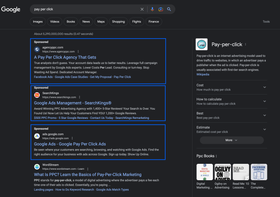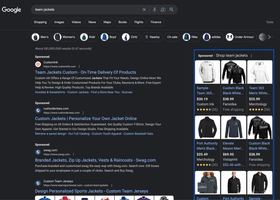Retargeting Ads in Less Than 10 Mins
Use this guide to understand what retargeting is, the different types, ways to get started, and best practices to keep in mind.
Read More
53% of all website traffic comes from search engines. There is a lot of opportunity for brands to get in front of potential customers in search, but how can a marketer drive the most site traffic when there are so many websites to compete with?
Search engine optimization (SEO) is the most effective way to drum up organic traffic, and it’s free! You don’t pay for this organic strategy. However, there’s a lot of stiff competition. Ranking on search engine results pages (SERPs) for popular terms is extremely difficult; it demands a lot of effort with an SEO strategy, and most of all, it requires time.
Search engines offer a solution to quickly tap into the number of searchers without a long-term SEO strategy: paid search.
Paid search is a marketing tactic in which advertisers pay search engines for ad placement on SERPs. Sometimes these ads are called Pay-Per-Click (PPC) ads. There are six different factors (called Ad Rank) that determine ad position on Google.
Bid amount - Working within an auction structure, businesses bid on keywords or phrases that indicate an interest in their product category. These ads work on a PPC basis, meaning that businesses only pay when ads are clicked.
Ad and landing page quality - Google assesses the relevance and usefulness of landing pages (mobile-friendly websites perform better!)
Ad thresholds - These include the following: ad quality, ad position, user signals and attributes, topic and nature of the search, and related auctions.
Popularity of keywords - If two ads have the same ad ranking, the one with the highest bid will win out. It’s important to note that the more bidders in an auction, the higher the price over time, and when you’re competing with large or established businesses, they may have the ability to bid higher. This means the cost-per-click (CPC) may be higher.
Context of search - The search term, location, time, device type, nature of the search, competing ads, and search results are some things that are taken into consideration, however can’t be well-controlled by the business advertising.Over time, you can report on these context areas and eliminate segments based on your findings.
Impact of ad extensions - Businesses have the option to include phone numbers and multiple links (e.g., ad extensions).
The look and feel of paid search ads can vary. Some can look like regular search results at the top of a SERP:
Other paid search ads can have the look and feel of a product page feed:
As explained above, the biggest difference between SEO and PPC is cost. SEO is a free strategy that anyone can use to rank a website on search engines. PPC on the other hand requires you to commit a budget, create ads and campaigns, and use an ad management dashboard.
Other differences include:
How the strategy is implemented, managed, and reported on
Often the teams that manage SEO and PPC strategies are not the same
PPC requires more day to day strategic changes and monitoring, whereas SEO is a long-term strategy built over time and adjustments are not as frequent
The strongest strategy a brand can have is one that includes a focus on both PPC and SEO. While paid efforts are high impact, there will always be a cost; think of them as a faucet you can turn on for results. Organic efforts have a high impact over time and the results aren’t immediate; think of this strategy as building a steady stream of results over time.
Wait, what’s SEM? Search Engine Marketing (SEM) is another term you may see used in the marketing world. This is another word for a paid search engine campaign, AKA PPC.
While there are a lot of nuances to paid search and its strategy, here’s the basic breakdown of how ads work:
Brands create a campaign based on goals, keywords, and other factors
A potential customer searches for the target keyword, and the ad appears in its placement (as determined by the process above)
The potential customer clicks on your ad and is redirected to the website page you determine
You pay per click to your website
Search engines are fertile soil for businesses looking to expand their customer base. Google alone handles over 3.5 billion searches a day, meaning that search engines will always have a guaranteed stream of high-quality traffic available for the picking. Let's go over some of the benefits of utilizing paid search ads:
By doing a bit of keyword research, businesses can target shoppers that are most likely to be in the market for their offerings. For example, if a fitness apparel company targets the keyword phrase "best running shoes" and delivers search ads to those who search for that term, they’re likely to reach shoppers who are looking to buy new running shoes. Matching search ads to search intent and keywords is the way to reach high-intent audiences.
Since search engines operate under a bidding format, they let the market dictate the price of ads. For example, if a business sets their maximum bid for a keyword at $5 and the highest competing bid is only $3, they’ll only pay $3.01. Most of the time, businesses pay less than the maximum bid price, and if there's an uptick in interest for a keyword by competitors, they have the option of changing their bid at any time.
Not only are the prices of these ads protected by the market, but they also deliver a great return on investment (ROI). On average, brands see a return of $8 for every dollar they spend advertising on Google.
Unlike other aspects of an SEO strategy, businesses can see measurable and quality results fairly quickly. The highly-targeted nature of paid search ads (as noted above), removes shoppers that would need a lot more persuading to purchase. So, businesses end up targeting shoppers that will have shorter customer journeys.
Additionally, launching and setting up a campaign takes very little time and effort. Brands don't have to worry about hiring a graphic designer or copywriter since search engines don't require creative assets (e.g., images or copy). That being said, paid search ad campaigns do require long-term maintenance, so don't set it and forget it. Make sure to check in periodically and make necessary optimizations when needed.
While there are other search engines you can run paid search campaigns on, Google is one of the most frequently chosen options. Here’s how you can create a paid search campaign using Google Ads.
Create a Search campaign in Google Ads.
Adjust your campaign settings like targeting, bidding, and ad assets.
Create ad groups. Ad groups are sets of keywords that are grouped together based on the way your customers shop. You can manually create your groups or let Google dynamically build your groups based on your site content.
Create your ads. You’ll need to do some copywriting here by crafting headlines and descriptions for each of your ad groups.
Set your budget. Your budget = how many views your ads will get. You’ll set a daily budget, but don’t worry. You won’t have to do that entirely yourself. Google will give you recommendations for budgeting.
For more step-by-step instructions and getting started in Google Ads.
Now that you’ve started on the basics of search ads, learn more about brand awareness, retargeting, social ads, and more in all of our resources below! Did you know, you can integrate your Google campaigns in AdRoll? Consolidate your data, streamline your reporting, and get better data to make better decisions. Learn more.
Last updated on June 15th, 2023.

